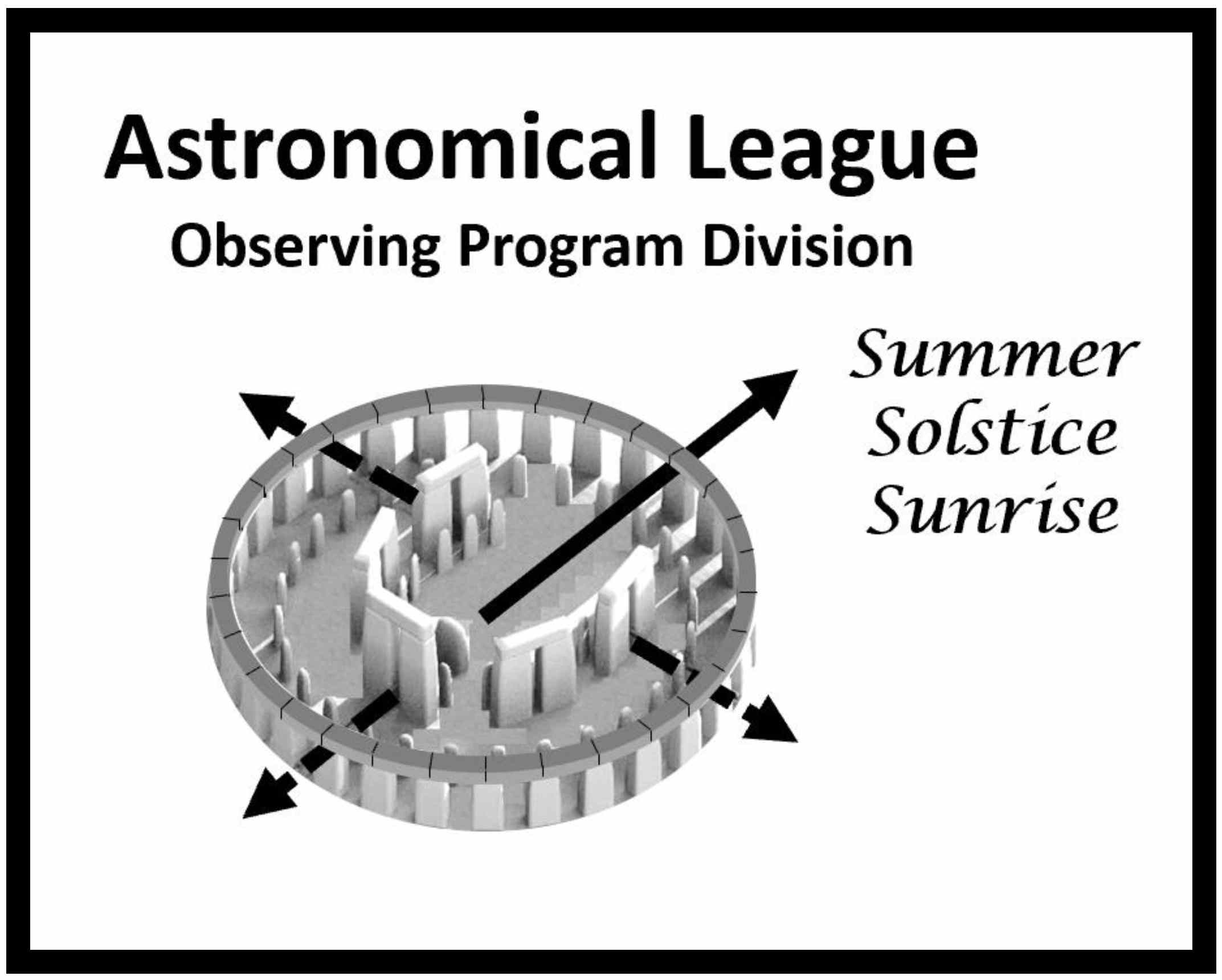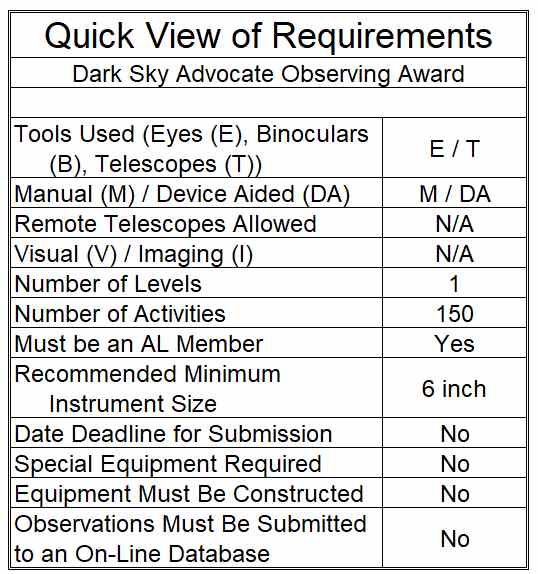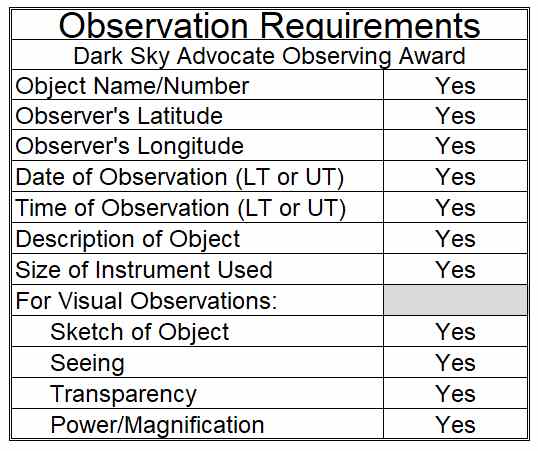Dark Sky Advocate Observing Award CoordinatorJohn Goss |
 |
IntroductionWelcome to the Dark Sky Advocate Award! This award is unlike any other. If you have wanted to do something about a topic so important to our hobby — the loss of our dark skies due to light pollution — this is a way you can help. Here lies a great opportunity for you, as you enter the Dark Sky Advocate Award, to make a positive, dramatic impact on your community that will be long-lasting and far-reaching. Can you imagine any better way you can influence the future? Light pollution and light trespass are two subtle but pervasive problems that degrade our quality of life and destroy our enjoyment of the night skies. Too many amateur astronomers have silently witnessed the unnecessary destruction of the night, first beginning in the cities but now spreading to the remaining rural areas. We must not choose to ignore this problem. BackgroundObjectives:To become a Dark Sky Advocate, the candidate must understand the problem of light pollution. The candidate must know its causes and solutions. The candidate must realize how it affects our society in general and amateur astronomy in particular. These objectives are achieved by the completion of various activities, some are observing related and most are not. |
 |
Eligibility:
All Astronomical League members, whether they belong to a club or are individuals registered as a Member at Large, Patron, or Lifetime, are eligible to receive the Dark Sky Advocate Award once they meet the qualifying requirements. This award shall not be counted towards the requirements of the Master Observer Award.
Requirements and RulesThis certification is available to members of the Astronomical League, either through their local astronomical society or as members at large. If you are not a member and would like to become one, check with your local astronomical society, search for a local society on the Astronomical League Website, or join as a Member-At-Large at the AL Store. To qualify for the award, the Dark Sky Advocate candidate must accumulate at least 75 points within both the Personal Enlightenment and Public Enlightenment sections, giving a total of 150 or more points. |
 |
Dark Sky Advocate – Activities List: |
|
| I. Personal Enlightenment and Education | |
| 1. _____ 5 points | Provide a copy of a local outdoor lighting ordinance. In the document, highlight where good lighting is described. |
| 2. _____ 10 points | Provide three photographs each of good and bad lights in your area. (A total of 6 photographs are required.) Describe why they are good or bad. |
| 3. _____ 10 points | Provide three photographs illustrating either the problem of glare or the solution of glare abatement (shielding). |
| 4. Compare the views through an eyepiece under various lighting conditions. The degraded telescope views in a light-polluted area dramatically affect our hobby in a very negative manner. Draw the same deep sky objects using the same telescope and eyepiece under the three lighting conditions described below. Artistic excellence is not required! Observe and draw at least one deep sky object of these five types: open cluster (preferably either M35 or M11), globular cluster (preferably either M13 or M3), planetary nebula (preferably either M27 or M57), diffuse nebula (preferably either M16 or M42), and galaxy (preferably either M31 or M81/M82). Negative sightings are acceptable. Objects should be 30º or higher in the sky and there should be no moon present. Be sure to label each of your drawings with the name of the object, the date and time observed along with the observing conditions and the observing location. Include the telescope aperture and the magnification used. | |
| i. _____ 10 points | From a light-polluted area (such as a parking lot) with direct light striking the telescope. Observing Location: _______________ Open Cluster Name: _______________ Globular Cluster Name: _______________ Planetary Nebula Name: _______________ Diffuse Nebula Name: _______________ Galaxy Name: ________________Be sure to submit your properly labeled drawings, as requested above, of the five objects. |
| ii. _____ 10 points | From a “city” dark area (no direct light striking the immediate area around the telescope). Observing Location: _______________ Open Cluster Name: _______________ Globular Cluster Name: _______________ Planetary Nebula Name: _______________ Diffuse Nebula Name: _______________ Galaxy Name: ________________Be sure to submit your properly labeled drawings, as requested above, of the five objects. |
| iii. _____ 10 points | From a dark sky site that has a limiting magnitude dimmer than magnitude 5.0 (no light striking the immediate area around the telescope). Observing Location: _______________ Open Cluster Name: _______________ Globular Cluster Name: _______________ Planetary Nebula Name: _______________ Diffuse Nebula Name: _______________ Galaxy Name: ________________<Be sure to submit your properly labeled drawings, as requested above, of the five objects. |
| 5. Estimate the limiting magnitude from both a light-polluted and a dark sky observing location. Be sure that there is no Moon in the sky and be sure to label your drawings as requested below. | |
| i. _____ 10 points | Star Count – count and draw all the stars of either Orion or Cygnus from both light polluted and dark sky locations. Light-polluted location: ________________ Constellation: ________________ Date: __________ Time: __________ Seeing conditions: __________Be sure to include your drawing.Dark sky location: ________________ Constellation: ________________ Date: ________________ Time: ________________ Seeing conditions: __________Be sure to include your drawing. |
| ii. _____ 10 points | Time and Day Differences Select either Orion or Cygnus and do star counts at different times of night, days of the week, and times of the year from the same observing location. Draw the stars that you see. Observing Location:_________________________ Constellation: __________ Time: __________ Day of the week: ___________ Date: __________ Seeing conditions: __________Be sure to include your drawing of the constellation.Time: __________ Day of the week: __________ Date: __________ Seeing conditions: __________Be sure to include your drawing of the constellation.Time: __________ Day of the week: __________ Date: __________ Seeing conditions: __________Be sure to include your drawing of the constellation.Time: __________ Day of the week: __________ Date: __________ Seeing conditions: __________Be sure to include your drawing of the constellation. |
| 6. Demonstrate knowledge of the non-astronomical aspects of the issue. | |
| i. _____ 10 points | Economic. Find your electric rate as expressed in cents per kilowatt-hour. Then compute your local annual electrical cost of operating unshielded dusk-to-dawn lights. Be aware that the rate charged may vary during the year. Repeat the calculations using low-wattage, shielded lights. Submit your calculations. |
| ii. _____ 5 points | Nature and wildlife. Submit magazine or newspaper articles that discuss environmental issues and lighting, or submit ads for wildlife-friendly fixtures. |
| iii. _____ 5 points | Medical. Submit magazine or newspaper articles that discuss health issues and lighting. |
| iv. _____ 5 points | Crime. In your area, when does more crime occur: from 7:00 a.m. to 7:00 p.m. or from 7:00 p.m. to 7:00 a.m.? Ask your local law enforcement authorities for a breakdown of the times of day when crimes occur. Report those statistics. Please include the name of your local police or sheriff’s department. Law enforcement Agency: ____________________ Crime Statistics, 7 a.m. – 7 p.m.: ________________ Crime Statistics, 7 p.m. – 7 a.m.: ________________ |
| __________ Total Points out of a maximum of 100. Remember, there must be a total of at least 75 points from section I. | |
II. Public Enlightenment and Raising Awareness |
|
| 1. _____ 20 points | Develop a presentation describing the lighting problem in your area. Include local examples, good and bad. Submit either the presentation itself or its outline. What is your target audience? |
| 2. _____ 5 points | Prepare and submit a handout for the public that describes the problem and gives solutions. /td> |
| 3. _____ 10 points | Draft and submit a sample (or actual) letter to government officials that describes the need for better outdoor lighting. |
| 4. _____ 10 points | Draft and submit a sample (or actual) letter to your local media that discusses the issue. This includes letters-to-the-editor and op-ed pieces to your local newspaper. |
| 5. _____ 20 points | Give at least three Dark Sky presentations that reach a combined total of fifty or more people. 1a. First Event name: ______________ 1b. Date: ________ 1c. No. people attending: _____ 2a. Second Event name: ___________ 2b. Date: ________ 2c. No. people attending: _____ 3a. Third Event name: _____________ 3b. Date: ________ 3c. No. people attending: _____Total number of people attending (needs to be 50 or more): __________ |
| 6. Contact efforts to affect change | |
| i. _____ 10 points | Draft and submit a minimum of three sample (or actual) letters to different businesses commending them for their good lighting. |
| ii. _____ 10 points | Draft and submit a minimum of three sample (or actual) letters to different concerns, either private or public, requesting that they upgrade to shielded outdoor lighting. |
| 7. _____ 5 points | Dillon’s Rule. Please answer the following questions:
i. Is your state a Dillon’s Rule state or a Home Rule state? ___________________________ |
| 8_____ 10 points | Outdoor lighting ordinance. What key components should it contain? Refer to the IDA’s “Simple Guidelines for Lighting Regulations.” ______________________________ |
| __________ Total Points out of a maximum of 100. Remember, there must be a total of 75 points or more from section II. | |
| Completion ___________ Total of both sections: I. Personal Enlightenment and Education and II. Public Enlightenment and Raising Awareness. | |
Submitting for Certification
| Total your points. Once you reach at least 75 points from each section for a combined total of 150 points or more, you may submit all your completed project materials to the Observing Program Coordinator.
Please include your name as you wish it to read on your certificate of completion. Also, include the name of your astronomy club and indicate if you are a Member at Large, Patron, or Lifetime member. Be sure to include your mailing address, email address, and phone number. Make sure all the appropriate designations, labels, dates, times, observing conditions, and all the required information are included. Please indicate where the certificate and pin should be sent after the submitted material is approved. Submitted materials will not be returned. You should send COPIES instead of the original documents. |
 |
Dark Sky Advocate Award Coordinator:John Goss Upon verification of your submission and of your active membership in the Astronomical League, your recognition (certificate, pin, etc.) will be sent to you or to the awards coordinator for your society, as you specified. Your name will also appear in an upcoming issue of the Reflector magazine and in the Astronomical League’s online database. Congratulations. Good luck with your next observing challenge. |
|
Notes:
- Various IDA handouts: provide a suggested list of pertinent IDA material. http://www.darksky.org #26: Economic issues in wasted and inefficient outdoor lighting #51: Lighting and Crime #182: Artificial Lighting and Wildlife — A Moth to a Flame #187: Lighting and Wildlife: 101 Introduction Simple Guidelines for Lighting Regulations
- “Earth at Night” posters; City light overlay on Google Earth
- Books on why the dark hours are important: The Ecological Consequences of Artificial Night Lighting
- Urban observing book: “City Astronomy,” Scagell, Robin, Sky Publishing, 1994.
- Astronomical League Urban Club: http://test.astroleague.org/al/obsclubs/urban/urban.html
- Explanation of Dillon’s Rule “Dillon’s Rule and the Birth of Home Rule,” by Diane Lang, Assistant Information Services Director Reprinted from The Municipal Reporter, December 1991
- IDA slide sets.
- IDA postcard template to Planning and Zoning Commissioners.
- SELENE (Sensible and Efficient Lighting to Enhance the Nighttime Environment): http://www.selene-ny.org/ How Glare Reduces Safety 10. General overview article: Owen, David, “The Dark Side,” The New Yorker, August 20, 2007.



